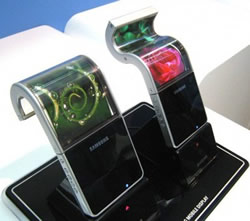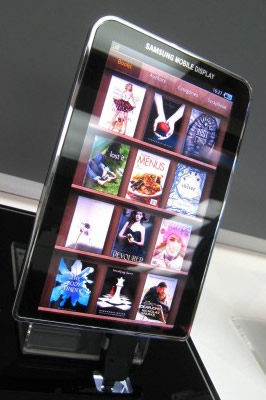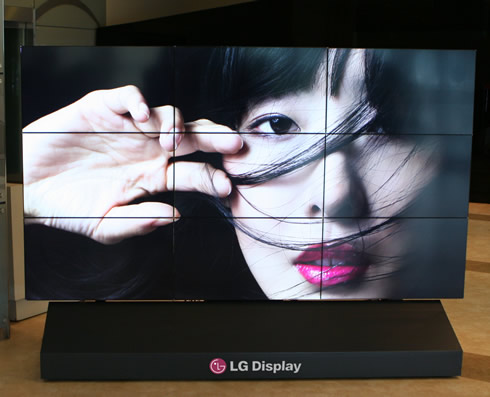
Samsung, LG Show Flexible OLED And E-paper Screens at FPD 2010
Samsung Electronics and LG Display have showcased many new display prototypes at FPD International 2010 in Japan this week. Among them there are many flexible displays that can be bent while continuing to show images.
Samsung's screens are based on OLED and LG Display's screen is an e-paper display. Both are on show at this week's FPD International event in Japan.
Samsung's prototype flexible OLED screens were on show in two sizes: a 4.5-inch screen with 480 pixels by 800 pixels resolution, and a 2.8-inch screen with 240 pixels by 400 pixels resolution.
Samsung also showacased new dual 4.5-inch displays boast a 100,000:1 contrast ratio each when implemented in the device, with it functioning like a netbook with a touch interface located at the bottom. The display has the same specs as above but a higher 300 cd/m2 brightness and a 100,000:1 contrast ratio.
 Samsung also demostrated a 7-inch Super AMOLED prototype panel, which willpossibly find its way at the company's next Galaxy Tab tablet device. It has got the same 1024 x 600 resolution (169 PPI) with 16.7M colors, 250 cd/m2, wide viewing angles and > 100% NTSC color space.
Samsung also demostrated a 7-inch Super AMOLED prototype panel, which willpossibly find its way at the company's next Galaxy Tab tablet device. It has got the same 1024 x 600 resolution (169 PPI) with 16.7M colors, 250 cd/m2, wide viewing angles and > 100% NTSC color space.
A transparent AMOLED display was showcased in a prototype 14-inch notebook. For the size, the resolution was only 960 x 540 pixels (78 PPI) and 250 cd/m2 brightness.
The LG e-paper screen showcased at FPD 2010 was a 19-inch model. It was demonstrated gently flexing while the image was shown on screen and appeared to show no signs of trouble dealing with the movement.
The thickness of the e-paper device, which LG Display claims is the world's largest flexible e-paper device, is 0.601mm including its protective film. The device drives E Ink's e-paper by using amorphous silicon (Si) TFTs formed on a stainless substrate.
The pixel count and resolution of the e-paper device are 2,560 x 1,600 and 163ppi, respectively. It can display 16 levels of grayscale. Its reflectance is 40% or higher, and its contrast ratio is 7:1 or hither.
The viewing angle of the e-paper device is 140°, horizontally and vertically. Its gate driver circuit is formed by using amorphous Si TFTs.
LG Display also showcased a 9.7-inch color e-paper device whose pixel count is 800 x 600. It can display 4,096 colors and has a 2.9% color gamut on NTSC standards. Color filter layers of red, green, blue and white colors are directly formed on an e-paper film. Its reflectance and contrast ratio are 26% and 10:1, respectively.
LG Display had also developed a panel for public displays featuring the world?s narrowest bezel. With the latest 37-inch LCD panel for public display, the gap between panels is just 4" (left/right: 1.5", top/bottom: 2.5"). As the product has extremely thin borders, it produces a seamless-looking images when many panels are arranged together to create a large screen.
The product was showcased in nine panels (3 by 3 arrangements) to create a 111-inch multi-vision display, at FPD (Flat Panel Display) International Japan 2010.
The companies didn't say when these prototypes would be commercially available.

Samsung's prototype flexible OLED screens were on show in two sizes: a 4.5-inch screen with 480 pixels by 800 pixels resolution, and a 2.8-inch screen with 240 pixels by 400 pixels resolution.
Samsung also showacased new dual 4.5-inch displays boast a 100,000:1 contrast ratio each when implemented in the device, with it functioning like a netbook with a touch interface located at the bottom. The display has the same specs as above but a higher 300 cd/m2 brightness and a 100,000:1 contrast ratio.

 Samsung also demostrated a 7-inch Super AMOLED prototype panel, which willpossibly find its way at the company's next Galaxy Tab tablet device. It has got the same 1024 x 600 resolution (169 PPI) with 16.7M colors, 250 cd/m2, wide viewing angles and > 100% NTSC color space.
Samsung also demostrated a 7-inch Super AMOLED prototype panel, which willpossibly find its way at the company's next Galaxy Tab tablet device. It has got the same 1024 x 600 resolution (169 PPI) with 16.7M colors, 250 cd/m2, wide viewing angles and > 100% NTSC color space.
A transparent AMOLED display was showcased in a prototype 14-inch notebook. For the size, the resolution was only 960 x 540 pixels (78 PPI) and 250 cd/m2 brightness.
The LG e-paper screen showcased at FPD 2010 was a 19-inch model. It was demonstrated gently flexing while the image was shown on screen and appeared to show no signs of trouble dealing with the movement.
The thickness of the e-paper device, which LG Display claims is the world's largest flexible e-paper device, is 0.601mm including its protective film. The device drives E Ink's e-paper by using amorphous silicon (Si) TFTs formed on a stainless substrate.
The pixel count and resolution of the e-paper device are 2,560 x 1,600 and 163ppi, respectively. It can display 16 levels of grayscale. Its reflectance is 40% or higher, and its contrast ratio is 7:1 or hither.
The viewing angle of the e-paper device is 140°, horizontally and vertically. Its gate driver circuit is formed by using amorphous Si TFTs.
LG Display also showcased a 9.7-inch color e-paper device whose pixel count is 800 x 600. It can display 4,096 colors and has a 2.9% color gamut on NTSC standards. Color filter layers of red, green, blue and white colors are directly formed on an e-paper film. Its reflectance and contrast ratio are 26% and 10:1, respectively.
LG Display had also developed a panel for public displays featuring the world?s narrowest bezel. With the latest 37-inch LCD panel for public display, the gap between panels is just 4" (left/right: 1.5", top/bottom: 2.5"). As the product has extremely thin borders, it produces a seamless-looking images when many panels are arranged together to create a large screen.
The product was showcased in nine panels (3 by 3 arrangements) to create a 111-inch multi-vision display, at FPD (Flat Panel Display) International Japan 2010.
The companies didn't say when these prototypes would be commercially available.






















